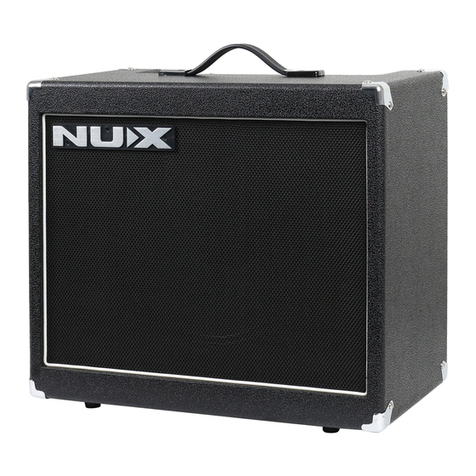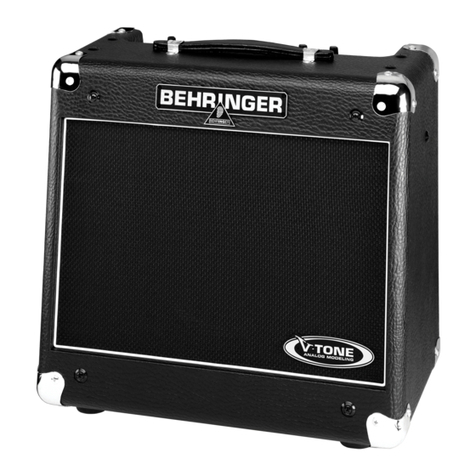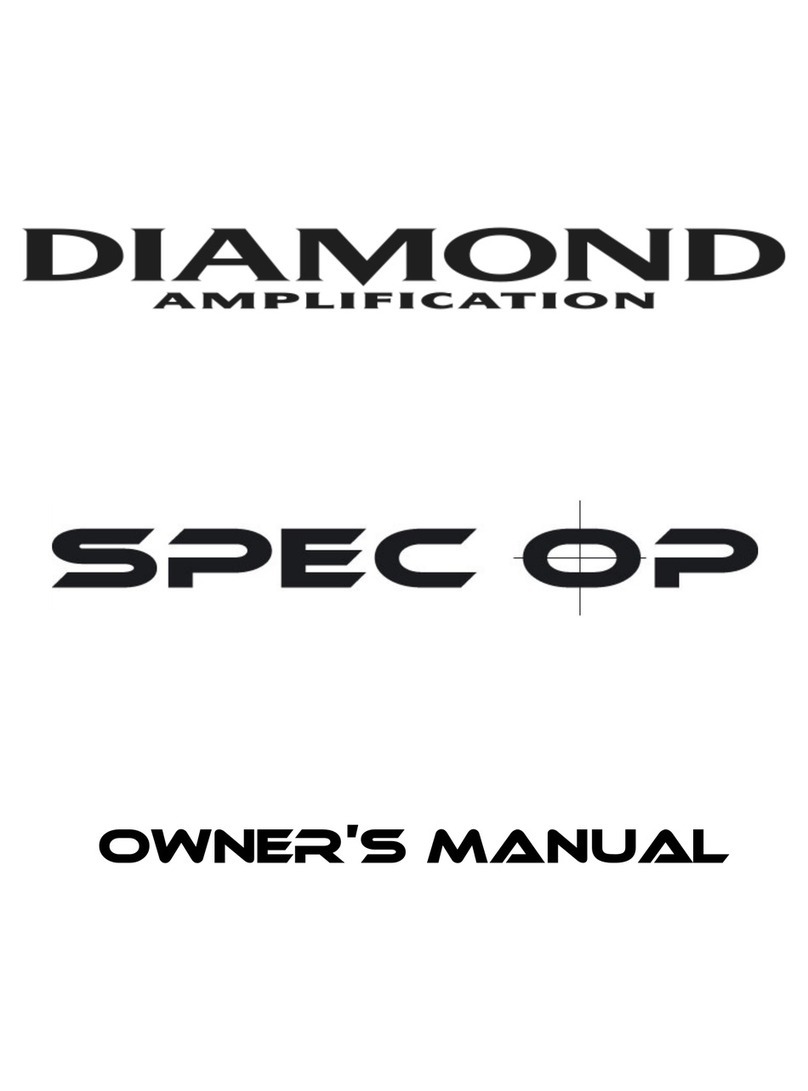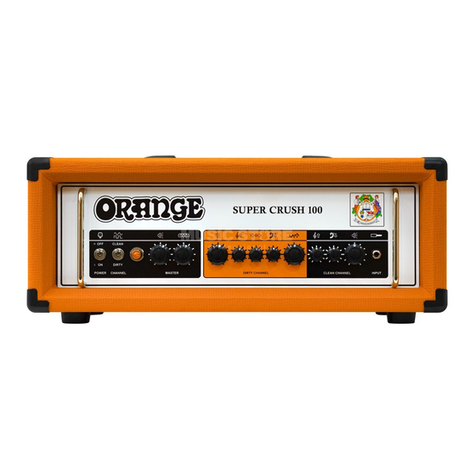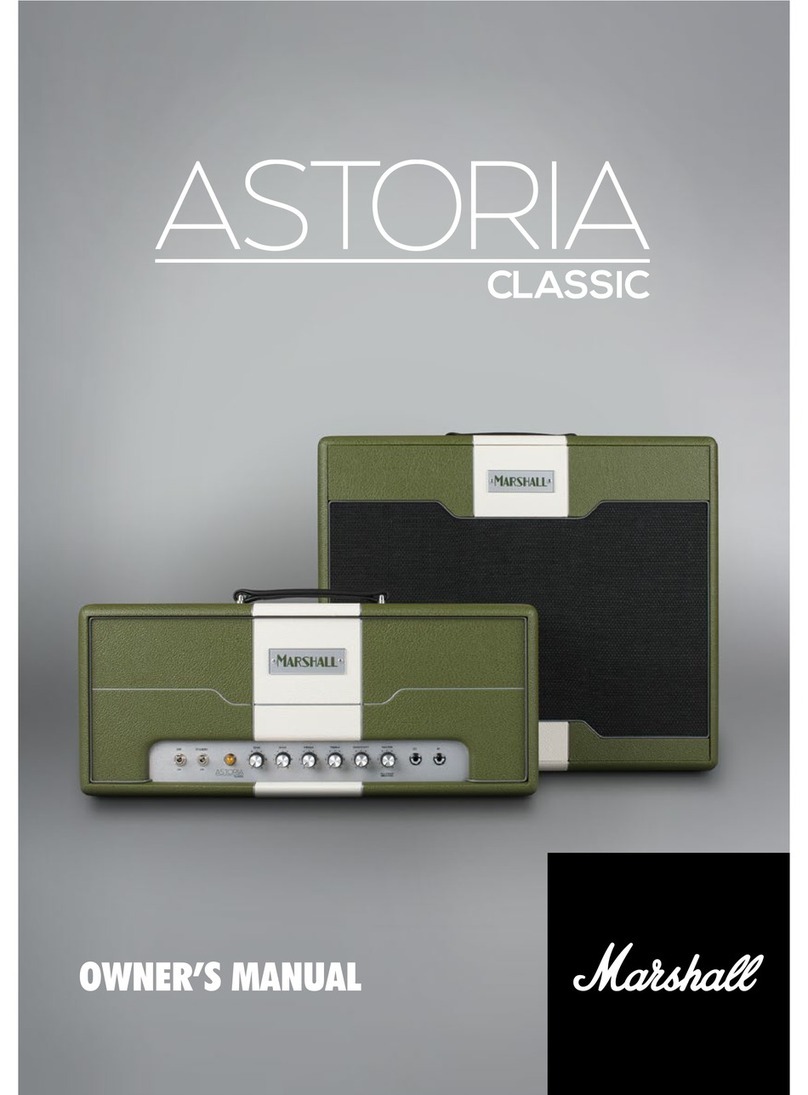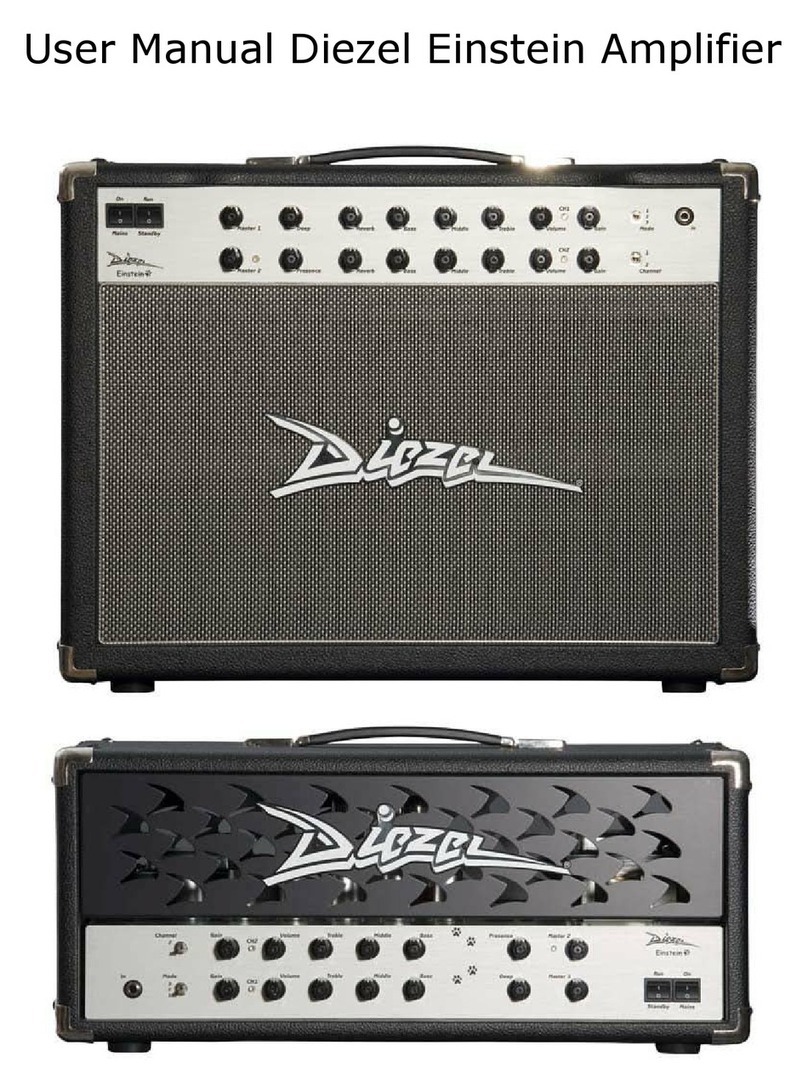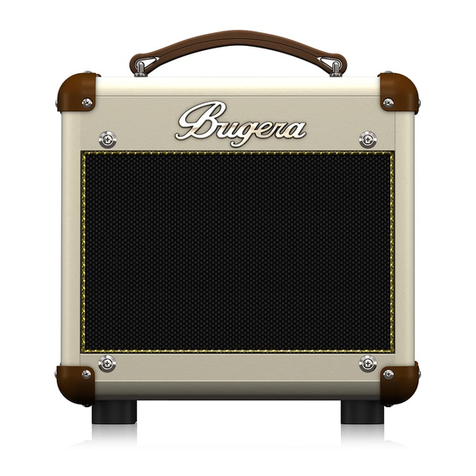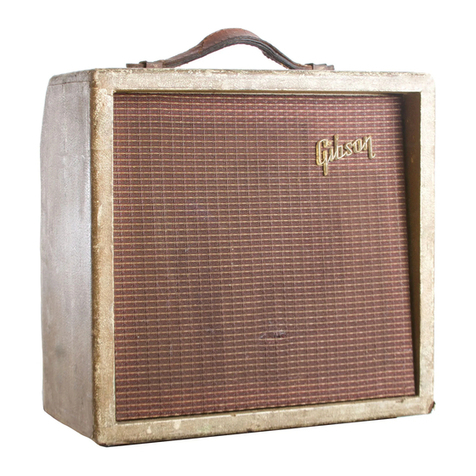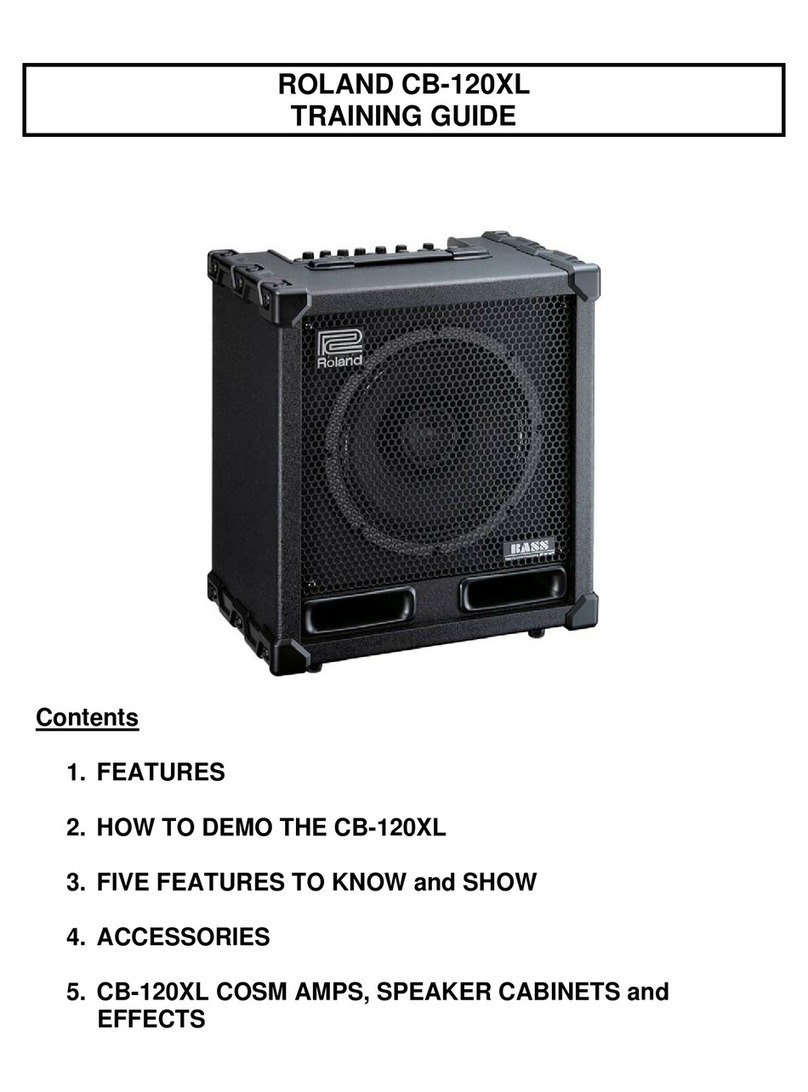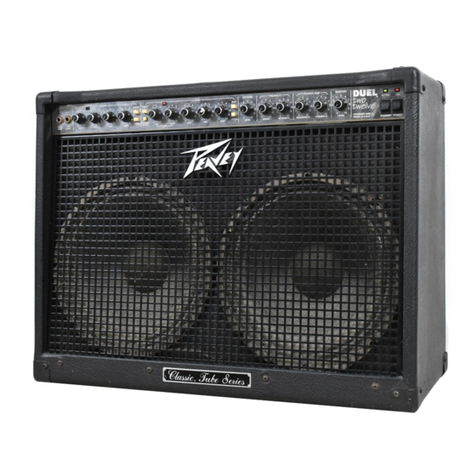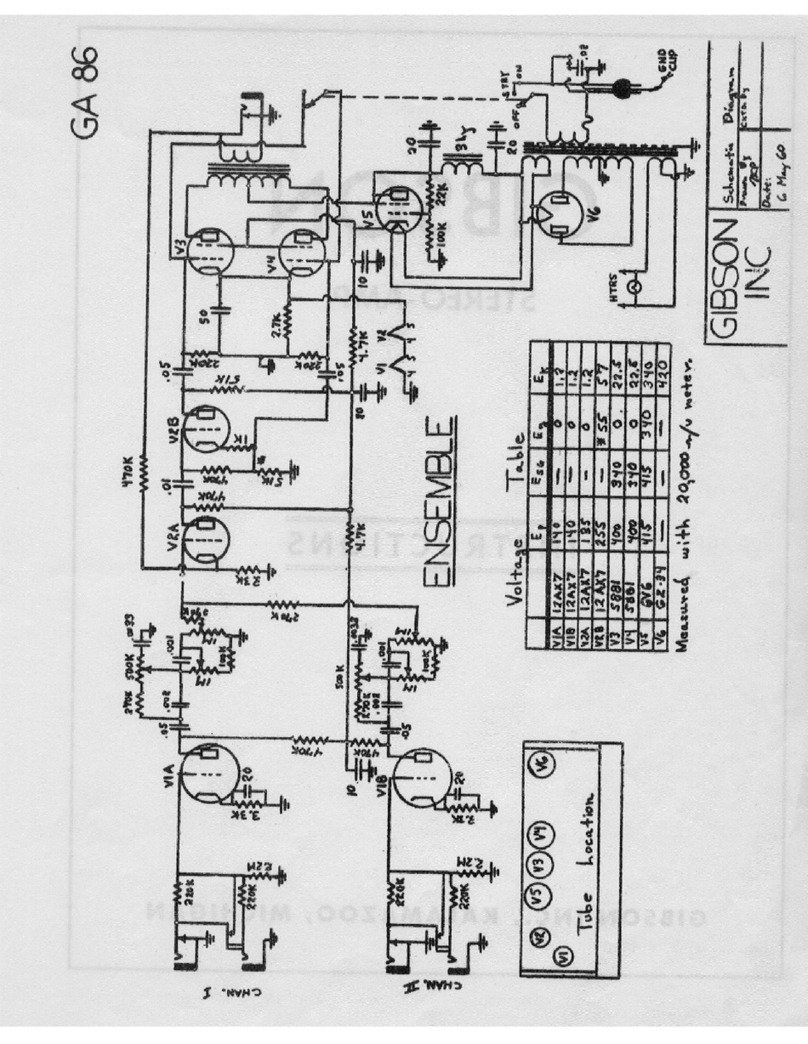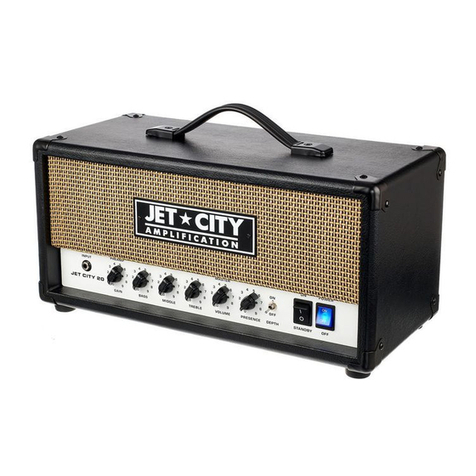SWR 350x User manual

350x350x
OWNER’S MANUALOWNER’S MANUAL
SWR SOUND CORP. • SUN VALLEY, CA • USA

IMPORTANT SAFETY INSTRUCTIONSIMPORTANT SAFETY INSTRUCTIONS
CAUTION: TO REDUCE RISK OF ELECTRIC SHOCK, DO NOT REMOVE THE COVER OR BACK.
NO USER-SERVICEABLE PARTS INSIDE. PLEASE REFER TO A QUALIFIED SERVICE TECHNICIAN.
A. Read Instructions: All safety and operation instructions should be read before the product is operated.
B. Retain Instructions: The safety and operating instructions should be retained for future reference.
C. Heed Warnings: All of the warnings on this product and in the operating instructions should be adhered to.
D. Follow Instructions: All operating and use instructions should be followed.
E. Cleaning: Unplug this product from the wall outlet before cleaning. Do not use liquid cleaners or aerosol cleaners. Use a slightly
damp cloth for cleaning.
F. Water and Moisture: Do not use this product near water; for example, near a swimming pool, wet basement, and the like.
G. Accessories: Do not place this product on an unstable cart, stand, tripod, bracket or table. The product may fall, causing
serious injury to a child or adult, and serious damage to the product.
H. Ventilation: Slots and openings in the unit are provided for ventilation and to ensure reliable operation of the product, to protect it
from overheating, thus these openings must not be blocked or covered. This product should not be placed in a built-in installation such
as a bookcase or rack unless proper ventilation is provided or the manufacturer's instructions have been adhered to.
I. Grounding: This product is equipped with a three-wire grounding-type plug, a plug having a third (grounding) pin. This plug will only
fit into a grounding-type power outlet. This is a safety feature. If you are unable to insert the plug into the outlet, contact your
electrician to replace your obsolete outlet. Do not defeat the safety purpose of the grounding-type plug.
J. Power Cord Protection: Power supply cords should be routed so that they are not likely to be walked on or pinched by items placed
upon them, paying particular attention to cords at plugs and the point where they exit the product.
K. Lightning: For added protection of this product during a lightning storm or when it is left unattended and unused for long
periods of time, unplug it from the wall outlet. This will prevent damage to the product due to lightning and power-line surges.
L. Overloading: Do not overload wall outlets or extension cords as this can result in a risk of fire or electric shock.
M. Object and Liquid Entry: Never push objects of any kind into this product through the openings as they may touch dangerous
voltage points or short out parts that could result in a fire or electric shock. Never spill liquid of any kind on the product.
N. Servicing: Do not attempt to service this product yourself as opening or removing covers may expose you to dangerous
voltage or other hazards. Refer all servicing to qualified service personnel.
O. Damage Requiring Service: Unplug this product from the wall outlet and refer servicing to qualified service personnel under the
following conditions:
1) When the power supply cord has been damaged
2) If liquid has been spilled or objects have fallen into the product
3) If the product has been exposed to rain, water, or other conductive liquids
4) If the product does not operate normally by following the operating instructions
5) If the product has been dropped or damaged in any way
6) When the product exhibits a distinct change in performance.
P. Replacement Parts: When replacement parts are required, be sure the service technician has used replacement parts specified by
the manufacturer or have the same characteristics as the original part. Unauthorized substitutions may result in fire,
electric shock, or other hazards.
Q. Safety Check: Upon completion of any service or repairs to this product, ask the service technician to perform safety checks to
determine that the product is in proper operating condition.
R. Heat: The product should be situated away from heat sources such as radiators, heat registers, stoves or other products that
produce heat.

INTRODUCTIONINTRODUCTION
Congratulations on your purchase of the SWR 350x Bass Amplifier! You now own the cornerstone amp of
SWR’s world-renowned Professional Line of products for bassists.
A little history: The SWR 350x is an upgraded version of the Bass 350, a model we’ve offered for over ten
years as a simple and straightforward solution for bassists who wanted the famous “SWR Sound" in the
simplest Professional Line package possible. Our top-selling Professional Line head for several years running,
the Bass 350 featured a tube preamp (using a specially-selected 12AX7A vacuum tube), SWR’s patented
“Aural Enhancer,” an easy-to-use 3-band EQ section, and a high-quality, discrete solid-state 350-watt power
amp capable of delivering enough power and headroom for most live applications. With a proven track record
among players of all levels, the Bass 350 has become a constant presence in live venues and studios alike.
The new 350x maintains all of these proven features while adding significant improvements. We’ve integrated
a new feature: our SubWave™ circuit, which produces a tone an octave below the original signal and tracks
as well or better than anything else on the market today. (The effect is foot-switchable, and we’ve provided a
footswitch for your convenience.) The XLR (Balanced) output circuit has been upgraded to include a variable
pad, and is quieter in terms of signal-to-noise ratio. Additionally, the unit is now lighter, quieter (in terms of
overall residual and white noise), and in our humble opinion, better-looking thanks to a cosmetic rework from
the ground up. And, of course, each 350x is still assembled by hand and individually sound-tested in the USA
at our factory in Southern California.
It’s all part of SWR’s commitment to continued improvement and refinement of even our most popular
models, so that we can continue to assist today’s bassist in the pursuit of the ultimate goal: finding
equipment that not only does the job, but actually enhances the overall musical experience and contributes to
the creative process. Everyone here at SWR sincerely hopes that the purchase of your 350x helps you get
there from here… and beyond.
Please take the time to read your User Guide thoroughly and completely, so that you can realize the full
potential of your new 350x Bass Amplifier. Once again, thanks for your purchase, and for letting SWR help
Amplify Your Future™.
Sincerely,
SWR Sound Corporation
350x OWNER’S MANUAL • 1

Note: Please take a moment to verify that the following items were included in your SWR 350x packaging:
AC Cable, User Guide, SubWave Activator Footswitch, 1/4" to 1/4" Footswitch Cable, SWR Catalog.
350X • FRONT PANEL FEATURES350X • FRONT PANEL FEATURES
•Dual independent input jacks compatible with both passive and active instruments
•Preamp Gain control with red LED clip indicator
•Aural Enhancer control
•SubWave™ Activator Switch (illuminated blue when engaged)
•SubWave™ Level control
•Bass control
•Midrange Level control
•Midrange Frequency control
•Treble control
•Effects Blend control (with pull-limiter-defeat option)
•Master Volume control
•Illuminated Neon Power On/Off switch
350X • REAR PANEL FEATURES350X • REAR PANEL FEATURES
• XLR Pad (Level) control
• XLR Output jack
• XLR Mode switch (Direct, Direct + Sub, Line)
• Ground/Lift switch for XLR Output jack
• Tuner Out jack
• Side-Chain Effects Loop (Effects Send and Effects Return 1/4" jacks)
• SubWave™ Activator Footswitch jack
• Fan Mode switch
• Two Speakon and two 1/4" Speaker Output jacks
• Speaker Fuse (3AG, 10-amp fast-blo)
• Line Fuse (3AG, 7-amp slo-blo)
• AC Power Cord Receptacle
ELECTRICAL SPECIFICATIONSELECTRICAL SPECIFICATIONS
Note: All measurements were taken with a line voltage of 120VAC. All noise specifications are “unweighted.”
All voltages and watts are “RMS.” All measurements are taken with tone controls set flat, Aural Enhancer at
minimum.
Power Ratings (minimum):
450 Watts @ 2 ohms
350 Watts @ 4 ohms
240 Watts @ 8 ohms
Frequency Response (power amplifier):
–3dB @ 20 Hz and 40 kHz
2 • 350x OWNER’S MANUAL

Sensitivity (full output under clipping, 8 ohms load, 100 Hz):
Passive Input Jack: 38 millivolts
Active Input Jack: 60 millivolts
Power Amplifier (Effects Return Jack “in”): 5 volts
Input Impedance
Passive/Active Input: 800k Ohms
Active Input: 60k Ohms
Effects Return: 27k Ohms
Output Impedance
Effects Send: 100 Ohms
Tuner Send: 100 Ohms
XLR (Balanced) Out: 750 Ohms
Signal To Noise Ratio: –72 dB (<10 millivolts typical)
Equivalent Input Noise: 9 microvolts
Dimensions (depth includes handles and XLR pad): 19" W x 3.5" H x 12.125" D
Weight: 17 lbs.
350x •350x • GETTING STARTEDGETTING STARTED
Connecting Your Speaker Cabinets
The 350x is a mono amplifier, which makes things fairly simple. Locate the “Speaker Outputs” section on the
rear of the amp. You will notice that there are four different speaker output jacks, two 1/4" type and two
Speakon type jacks. The Speakon jacks are preferable if your speaker cabinet is equipped with Speakons as
well; however, you can use any of the four available jacks to connect your speaker(s) to the 350x.
Using One Speaker Cabinet
Using a speaker cable of 18 gauge or heavier (the heavier the cable, the lower the gauge), simply connect
any one of the 350x’s Speaker Output jacks to the input jacks of your speaker cabinet. If your cabinet is a 4
ohm enclosure, the 350x will deliver 350 watts into it. If your cabinet is an 8 ohm enclosure, it will deliver
240 watts into it. Be sure to check the power handling capabilities of your speaker cabinet before connection
and operation.
Using Two Speaker Cabinets
Using a speaker cable of 18 gauge or heavier (the heavier the cable, the lower the gauge), simply connect
any of the 350x’s Speaker Output jacks to the input jacks of your two speaker cabinets. (You can use one
1/4" and one Speakon Output jack each if you wish; however, it is always best to use speaker cables with
similar type ends.) If the cabinets are the same impedance, the same amount of power will be sent to each
enclosure. If the cabinets are different impedances, more power will flow to the cabinet with the lower
impedance. Since the 350x is a mono amplifier and individual cabinet levels cannot be adjusted, it is
recommended that you use cabinets of the same impedance when using more than one cabinet. If you use
two 8 ohm cabinets—the two-cabinet setup recommended by SWR—the resulting “total” impedance will be 4
ohms, and the 350x will deliver 350 watts spread across both cabinets. Needless to say, in all cases, be sure
to check the power handling capabilities and impedance of your speaker cabinet(s) before connection and
operation.
350x OWNER’S MANUAL • 3

Important: The minimum total impedance when operating the 350x is 2 ohms. This means you can
safely use:
a) A single 8 ohm cabinet
b) A single 4 ohm cabinet
c) Two 8 ohm cabinets (total: 4 ohms)
d) Three 8 ohm cabinets (total: 2.6 ohms)
e) Two four ohm cabinets (total: 2 ohms) **
**Running the amplifier constantly at 2 ohms, while technically acceptable, will cause the amp to run hotter
than usual, and will cause heat-related wear on components sooner than normal.
More details are available in the “Speaker Outputs” section of this manual, and we strongly recommend that
you read the entire manual. However, this should be enough information to get you started.
Turning The Unit On
Remove the AC cable from the accessory pack and connect it from the amplifier to a standard wall outlet.
Make sure that the both the Gain and Master Volume controls are set to the minimum position. Locate the
power switch on the right side of the front panel and turn the amplifier on. The power switch should then
illuminate in red. Upon powering up, don’t be surprised if you hear a small pop. This is absolutely normal.
(Eliminating this “power on transient” would require a component called a relay. SWR chose not to incorporate
this type of component due to the fact that relays degrade signal quality and often fail, causing the unit to
have no output and requiring a trip to a local service center.)
Getting Sound Out Of The 350x
Plug your instrument into the desired input jack (please refer to “Front Panel Features” for more detail). Turn
your instrument’s volume up to at least 75% of maximum and slowly adjust up the Gain control. Keep playing
and turning the Gain control up until you see the Preamp Clip LED turn red. Then back off the Gain Control
about one large hash mark on the dial. Now turn up the Master Volume control to an equal level. You should
now hear the sound of your instrument amplified through the 350x into your speaker cabinet(s).
350x •350x • FRONT PANEL FEATURESFRONT PANEL FEATURES
Input Jacks
Both input jacks accept a standard 1/4" phone plug and both inputs can be used at the same time. Since the
two inputs are totally independent, no loss in volume or tone will occur by using two instruments
simultaneously. However, the main applicational use for the two separate input jacks is their difference in
level, as the Passive/Active input has five times more gain than the Active input. In other words, it’s not
necessarily intended as a “submixer” for two instruments, but no harm will come from having two instruments
plugged in at once. Please read below for more details.
Passive/Active Input Jack
This input jack is designed to accommodate both “passive” instruments and most “active” instruments. A
passive instrument has no built-in preamp and does not use a battery, while an active bass utilizes a
battery-operated preamp for gain, tone controls, or both. The Passive/Active Input will work with all instruments
having a maximum output of less than 1 volt RMS. Some active pickups such as EMG, Bartolini, etc., use bat-
teries for operation and will work perfectly using this input. Instruments made by MTD, Sadowsky, Modulus, etc.,
have active electronics that are suited for use in the Passive/Active input.
Generally speaking, try this input first. If you hear a small amount of distortion and the preamp clip LED is not
activated, try using the Active input jack. If the Active input does not correct any audible distortion, check the
battery in your bass.
Note: If you would like to overdrive the first TUBE stage, this can be accomplished by using an external
preamp between your instrument and the Passive/Active input. To obtain optimum sound when trying this,
make sure the preamp clip LED is not activated. If this occurs, turn down your Gain control until the LED
does not light. The first preamp tube stage is NOT monitored by the preamp clip circuit for this reason.
4 • 350x OWNER’S MANUAL

Active Input Jack
The Active input jack should be used with instruments having a built-in (on board) preamp or other sound
sources that will produce output levels greater than 1 volt RMS. The number of bass manufacturers has
increased significantly over the years, and it’s impossible to try and keep track of them all. Generally, if you
have very “hot” pickups and/or tone controls installed in your instrument, and you use them to boost the level
of your bass signal 10 dB or more, you may find the Active input more compatible. The best judge is your own
ears.
If you’re using a keyboard or bass pedal with the 350x, we have found the best choice to be the Active input.
Note: Using the Active input with passive basses (active instruments will always employ a battery) may
result in a loss of high end transients. Players who roll off their high end starting at about 2kHz, or prefer a
“darker” sound, may find this input more to their liking.
If you hear some distortion with your active bass and are using the Active Input, make sure the preamp clip
LED indicator is not lighting. If the preamp stage is not being driven into clipping, replace the battery in your
instrument.
Gain Control
The Gain control adjusts the volume of the preamp section. Since the Gain control is similar to a “pad,” a
small amount of signal will be heard even with the Gain control rotated fully counter-clockwise (“MIN”) if the
Master Volume is up.
After all EQ settings and the Aural Enhancer are set, the Gain control should be raised until the preamp clip
LED barely flashes when your loudest note is struck. This will insure maximum signal to noise ratio and pre-
vent unwanted clipping of the preamp section.
Note: The Gain can serve as an EFFECTS SEND LEVEL ADJUSTMENT. If your effect is being
overdriven, turn down the Gain control and readjust your Master Volume for overall loudness.
Preamp Clip LED
The preamp clip LED will light whenever the preamp, tone section or output buffer reach clipping (run out of
headroom). This function does NOT monitor the first tube stage of the Passive input. See that section for
more info.
In the event the clip indicator lights, turn down the Gain control. Since this circuit monitors the tone controls,
boosting any one of them can cause the clip LED to activate. Once again, you may leave the tone control at
its desired level, but turn the Gain control down further.
Note: Even though the Preamp Clip LED lighting indicates that at some point the preamp is clipping, no
harm is being done to your amplifier. However, clipping of the power amp can cause damage to your
speakers and is not recommended.
Aural Enhancer
The Aural Enhancer is a feature that’s been on just about every SWR amplifier since the company’s inception
in 1984, and is a trademark part of the “SWR Sound” people have come to know and love. It was developed
to help bring out the fundamental low notes of the bass guitar, enhance the high-end transients, and reduce
certain frequencies that help “mask” the fundamentals. The ultimate result is:
1. A more transparent sound, especially noticeable when slapping and popping.
2. It can make a passive bass take on an “active” type of quality when set at positions of “2 o’clock” or fur-
ther clockwise.
Let’s take a second to learn how the Aural Enhancer works. Think of it as a variable tone curve that changes
depending on where you set the Aural Enhancer control knob. As you raise the control clockwise from the
“MIN” position, you are elevating a whole range of sound (lows, mids, and highs) at a variety of frequency
points selected specifically because they’re different than those selected for the individual Tone Controls.
This remains true up to about the “2 o’clock” position. This position – a favorite for many users – brings out
both the low end fundamentals and crisp highs and, at the same time, adds a little lower midrange to help cut
through the band. However, if you go further clockwise and past the 2:00 position, selected mids will start to
drop off – specifically, a group of frequencies centered around 200 Hz. At this point and after, the effect
350x OWNER’S MANUAL • 5

becomes much more pronounced. However, the curves involved here are gentle, as opposed to the very
extreme curves you can create by boosting or cutting the Active Tone Controls (EQ).
Most significantly for basses, the Aural Enhancer will help bring out the fundamentals of your lower registers
without masking them with overtones, as is possible when using the Bass control only. At the same time, it
opens up the sibilance characteristics of all instruments without being harsh.
Obviously, numbers and curves and circuits all mean nothing compared to what you hear with your own ears.
Play a chord, a repeated lick, or a harmonic, and turn the Aural Enhancer control to various points on the
knob to hear the effect for yourself. As always, your ears are the best judge when it comes to settings that
affect the tone of your instrument.
SubWave™ Controls
Based on the circuit from SWR’s groundbreaking Mo’ Bass Soundstation, the SubWave™ on your 350x is a
lightning-quick sub-octave wave engine with tracking superior to other models of sub-octave effects currently
on the market. In plain terms, it hears the note you play and immediately generates a signal one octave
below it—all the way down to low “C#”, “C”, or even low “B” on some basses!
SubWave™ Activator Switch
Located directly above the SubWave™ Level Control, this is an illuminated push-button switch that
activates the SubWave™ effect. When engaged, the switch cap will illuminate in blue. Push once to
engage, then again to disengage. (The SubWave™ effect can also be switched on and off via foot-switch;
please see the heading titled “SubWave™ Footswitch” in the “Rear Panel Features” section later in this
manual.)
SubWave™ Level Control
Once the SubWave™ effect is engaged, you can use this control to determine the amount of effect to be
blended in with your original (“clean”) bass signal. Turning the control clockwise will increase the amount of
effect, while turning the control counter-clockwise will decrease the amount of effect. When the control is
set fully counter-clockwise to “MIN”, no effect will be heard, even though the effect is engaged and the
Activator switch is illuminated in blue. This is normal. Also, when the control is set fully clockwise to “MAX”,
the “clean” bass signal will still be present…along with plenty of sub-octave effect. As always, your ears
and the desired musical application will be the best judge in setting this control.
(Keep in mind that the Bass Level control will have a significant impact on the perceived level of the
SubWave™ effect as well, as it follows immediately after the SubWave™ in the signal chain. Please read
below.)
350x •350x • ACTIVE TONE CONTROL SECTIONACTIVE TONE CONTROL SECTION
Bass Control
The Bass control employs a shelving-type circuit and boosts or cuts the bass response + /–15dB, from about
30Hz to 100Hz. Starting at the control’s mid-position (“center-click”), turning the control counter-clockwise
cuts the bass response, and turning the control clockwise boosts the bass response.
You’ll find that the Bass Level control will boost or cut the SubWave™ effect along with the “clean” bass
signal. That’s because of the range of frequencies covered by this particular control. You can use both the
Bass and SubWave™ Level controls to get a good balance between how much bass you want in your clean
sound, and how much of a bass boost you want when engaging the SubWave™. Some users will want a
significant boost, while others may be striving for a more consistent level (or “unity gain”). Again, let your ears
and musical taste be the judge.
NOTE: Setting both the Bass and SubWave™ Level controls near or at maximum boost will increase the
overall amount of bass in your signal VERY SIGNIFICANTLY! We’re all in favor of that, just so long as your
speaker cabinet can handle the peak levels. Adjust the controls slowly, and use common sense.
6 • 350x OWNER’S MANUAL

Midrange Controls
Your 350x comes equipped with two different controls for setting the amount of midrange present: one for
boosting and cutting the level of midrange, and another for setting the specific midrange frequency that will
be adjusted in level.
Midrange Level Control
The Midrange Level control cuts or boosts the frequency set by the Midrange Frequency control. Starting at
mid-position, turning the Level control counter-clockwise cuts the desired tone. Turning the Level control
clockwise boosts the desired tone (set by the Midrange Frequency control). When the level control is set at
mid-position (“center-click”), turning the frequency control will have no effect on the sound.
To find the midrange area you are looking for:
1. Adjust the Midrange Level control to the full boost or cut position.
2. Rotate the Midrange Frequency control until the desired area you wish to cut or boost is found.
3. Adjust the Midrange Level control to the desired amount of cut or boost.
Midrange Frequency Control
The Midrange Frequency control sets the area that is to be cut or boosted by the Midrange Level control. If
the Midrange Level control is set at mid-position, turning the Frequency knob will have NO affect.
Some hints: If you need to “cut through” the band a little more, try boosting 200 to 400 Hz. If you like a
more transparent or “scooped” sound, try cutting at 800 Hz. The midrange controls are especially useful in
controlling fretless basses and their inherent qualities.
Treble Control
The Treble control employs a shelving-type circuit and boosts or cuts the high frequencies (and their
subsequent octaves) +/–15dB from about 2kHz to 14kHz. Starting at mid-position, turning the control
counter-clockwise cuts the treble response, while turning the control clockwise boosts the treble response.
Effects Blend Control
The Effects Blend Control “blends” the signal sent from your instrument with the signal coming from your
EXTERNAL effects unit. (In other words, it has nothing to do with the SubWave™ effect onboard your 350x.)
With the Effects Blend fully counter-clockwise (“DRY”), no signal from your external effects unit will be heard.
As you turn this control clockwise, more of the effect can be heard in the overall sound. When the Effects
Blend control is set fully clockwise (“WET”), no true or unaffected signal is heard other than what your exter-
nal effects unit provides. If your external effects unit has a similar control, adjust it to the fully clockwise
(“WET”) position. This will avoid any possible phasing problems.
The Effects Blend circuit is similar to that used on recording consoles with the effects loop on a “side chain”
to the normal circuit. Unless the control is set to the full “wet” position, you will always get the full sound of
your instrument AND get the diversity an effects unit offers. This circuit is also effective in reducing noise
generated by effects units because it is located after the gain stages in the preamp.
The Effects Blend control functions only when the Effects Loop is being used. It is activated when a 1/4"
phone plug is inserted into the Effects Receive jack (for more information, please see the heading titled
“Effects Loop” in the “Rear Panel Features” section later in this guide).
Limiter/Compressor Circuit
The Limiter found in the 350x is a soft knee type limiter. The Limiter circuit is located after (post) the Master
Volume and before (pre) the power amplifier. Therefore, the Limiter is driven by the Master Volume control. Its
threshold (starting point) is preset by the factory so that the user can get maximum overall apparent volume
without unduly overdriving (or “clipping”) the power amplifier, which can eventually damage the unit’s internal
circuitry. This can also be helpful in preventing speaker damage when running your system at high volumes.
Activating or Defeating the Limiter Circuit
You may either activate or defeat the Limiter circuit via the Effects Blend control, which doubles as an on/off
switch for the Limiter. The “In” position activates the Limiter Circuit, and is the default setting as shipped from
the factory. To defeat the Limiter, simply pull “out” on the knob of this control until you hear and feel a
350x OWNER’S MANUAL • 7

“click.” To re-engage the Limiter, push the control back in to its original position.
Limiter Active LED
When the threshold (starting point) of the Limiter circuit is reached, the Limiter Active LED will light, indicating
that the Limiter Circuit is active and helping to protect your power amplifier from clipping. The Limiter LED will
not illuminate when: a) the Limiter has been defeated by pulling out on the Effects Blend control; b) when
playing at levels not high enough to engage the circuit.
Note: If you have defeated the Limiter and you hear a loud, sharp distortion present in your sound – and
the Preamp Clip LED is not lighting up – re-engage the Limiter by pushing the Effects Blend control back
in. If the distortion goes away, you were probably clipping the power amp, which is not a good thing.
Remember, the Limiter circuit is there to protect your amplifier from such a state of operation.
Master (Volume) Control
The Master (meaning “Master Volume”) control adjusts the level being sent to the power amplifier in your
350x – it controls the overall volume of the unit. Turning the control counter-clockwise reduces the overall
level, while turning the control clockwise boosts the overall level.
Two notes: The Master control never affects the level present at the various audio output jacks on the rear
panel – it only affects the level being sent to the power amplifier, and subsequently, your speaker outputs
only. Also, losses caused by external effects units can be recovered by increasing the Master control.
Power On/Off Switch
This switch turns the complete unit on or off. Setting the switch upwards to the “On” position turns on the
unit, and the switch itself will illuminate in red. Setting the switch downwards to the “Power” position will turn
the unit off, and the red light inside the power switch will turn off as well.
350x •350x • REAR PANEL FEATURESREAR PANEL FEATURES
Balanced (XLR) Output
The Balanced XLR out is a true electronically balanced output, suitable for studio and “front-of-house” (live)
mixing consoles. The level present at this output can be adjusted by using the XLR Pad control (see the “XLR
Pad Control” section below for more details). The signal appearing at the Balanced Output is governed by the
setting of the three-position XLR Mode switch located directly below it (Line/Direct/Direct + Sub).
In the DIRECT position, the Balanced Output signal comes from directly after the first stage of the
specially-selected 12AX7 preamp tube, giving you the sound of your instrument and some added warmth. In
other words, it becomes an active TUBE direct box. In this position, no front panel controls are functional and
the SubWave™ is not present.
In the LINE position, all front panel controls – including the Aural Enhancer, SubWave™, and EQ controls – are
functional except the Master control, and the signal is essentially the same as that heard through your
speaker system. If you are using an external effects device in the effects loop, that signal will also be present
when in the LINE position (dictated by the setting of the Effects Blend control on your 350x). When in this
position, the output level will be affected by the Gain control on the front panel as well as the XLR Pad
control. It’s worth noting that changing the level of the Gain control will affect the signal present at your
speakers, the Effects Send jack, and the Balanced Output, while the XLR Pad control affects the level present
at the Balanced Output only. For this reason, it’s usually better to set your Gain control in accordance with
the directions in the “Gain Control” previously listed in the “Front Panel Features” section of this manual, and
to use the XLR Pad control to set the level specifically for the Balanced Output.
The third position for this switch is the DIRECT + SUB position. In this position, the signal present at the
Balanced Output jack is the same as when in the DIRECT position, with one important exception: the
SubWave™ is present. What’s the benefit of this setting?
We’ve found that most people who use effects pedals prefer to use them in front of the amplifier. In other
words, they run their bass into the effect pedal’s input, then from the effect pedal’s output into the front of
their amplifier. In live applications where sound reinforcement is required, often times the front-of-house
engineer will take a direct signal from the bass itself (via either a direct box, or the Balanced Output of your
8 • 350x OWNER’S MANUAL

350x OWNER’S MANUAL • 9
amp set to the DIRECT position) and use that signal as the main bass sound to the house P.A. This way, if the
bassist sets the amplifier’s EQ controls in a way to his liking, but in a manner not conducive to a good bass
sound for the house P.A., the front-of-house mixing engineer still has a nice, flat bass signal to work with, and
then he can EQ the bass sound for what’s best in the room. And, more relevantly, he would still get the
sound of any effects pedal that was placed in front of the amplifier.
The DIRECT + SUB position provides this exact function for the Balanced Output. It always contains the
sound of your bass signal just after the first tube stage, and will also contain the SubWave™ effect when
engaged without also sending EQ settings that may not be right for the house P.A. (or a studio mixing
console). You can always include all of your EQ settings (plus the SubWave) at the Balanced Output by setting
the three-position switch to the LINE position. But thanks to the DIRECT + SUB position of this switch, it’s
not a necessity that you do so just because you want the SubWave™ present at the Balanced Output.
Note: You can still use the SubWave™ Level control to set the amount of sub-octave effect present at the
Balanced Output when in the DIRECT + SUB mode; however, it will also affect the level present at the
speaker outputs as well. Also, though the Gain control will not affect the level of the “clean” bass signal
present at the Balanced Output when in DIRECT + SUB mode, it WILL affect the level of sub-octave
present. This is normal, and occurs because the SubWave™ circuit is located after the first stage of the
preamp tube and is blended back into the signal specifically for this special mode of the three-position
switch. We recommend that you set the Gain and SubWave™ Level controls in accordance with previously
mentioned instructions, and the gain structure should fall into place fairly automatically.
Wiring for the XLR jack at the Balanced Output is as follows:
Pin 1 = ground, Pin 2 = + (plus), Pin 3 = – (minus)
(American Standard)
Note: Turn off transients appear at the Balanced Output when the amplifier is shut down. We recommend
that equipment being used in conjunction with the Balanced Output be turned down, off, or disconnected
BEFORE the 350x is turned off.
XLR Mode Switch (Line/Direct/Direct + Sub)
This three-position switch determines the signal present at the Balanced (XLR) Output jack as described in
the section directly above. In simple terms:
1. Direct = pre-EQ and SubWave™, post-first tube stage
2. Line = post-EQ and SubWave™
3. Direct + Sub = pre-EQ/post-first tube stage blended with SubWave™
Make sure the switch is set either to full left, full right or center to avoid an intermittent condition.
XLR Pad Control
This control sets the level present at the Balanced (XLR) Output. Turning the control counter-clockwise
reduces the overall level, while turning the control clockwise boosts the overall level. It should be noted that
turning the control fully counter-clockwise to “Min” does not fully defeat the signal. This is normal, as the XLR
Pad is designed to provide a range of usable levels to be sent to a front-of-house or studio mixing console.
XLR Ground/Lift Switch
Sometimes connecting to certain mixing boards or studio consoles with non-standard XLR wiring can cause a
ground loop. Your 350x has a push-button switch for lifting the ground on the Balanced (XLR) Output. (It
affects no other outputs.) Pushing on the switch will change the mode of operation. When the switch is in the
“out” position (default setting from the factory), ground is on Pin 1 of the Balanced Output jack as normal.
When the switch is in the “in” position, the ground is lifted from Pin 1 of this output. If a persistent hum
exists after trying both positions of the ground lift, there is probably:

1. A bad cable or connection somewhere between your Balanced Output jack and the snake leading to the
mixing console;
2. A dirty or miswired A/C socket;
3. Mis-wired or poorly wired A/C in the building;
4. Fluorescent lighting directly above you or in close proximity (especially when using single-coil pickups)
5. A cell phone in your right pocket that’s interacting with the electronics in your bass (don’t laugh, this
actually happens!)
But, in the case of a true ground loop, this switch can often times solve the problem.
Tuner Out
The Tuner Out function allows the user to plug their instrument tuner into this jack and “tune up” without
having to unplug and go back and forth from amp to tuner. This feature is totally isolated from the rest of the
preamp and will function regardless of the settings on the front panel. Being isolated on a side chain avoids
loading down of the instrument, which can cause a loss in dynamic range.
To use this feature, connect a shielded patch cord from the Tuner Out jack on your 350x to the input jack on
your tuner. Turn the amplifier on and you’re ready to go. If you do not wish to monitor your sound during the
tuning process, you may turn down the Master Volume.
Effects Loop (for external effects devices)
As mentioned previously in the “Effects Blend Control” section of the manual, the Effects Blend circuit in your
350x is similar to that used on recording consoles, with the effects loop on a “side chain” to the normal
circuit. Unless the Effects Blend control is set to the full “wet” position, you will always get the full sound of
your instrument AND get the diversity an external effects unit offers. Use of the effects loop will reduce the
noise generated by external effects units (as compared to using the effect between your instrument and the
input jack, though many people use it in this fashion anyway). This is because the loop is after the preamp
gain stages.
The Effects Loop is compatible with most individual or multi-effect external effects devices. Many effects
devices on the market have input level adjustments. For instance, some units have a switch that you can set
for either -20 dB or +4 dB. In all cases, these should be set for 0 dB (if available) or +4 dB. The level going
to your effect is controlled by the Gain control on the front panel.
Note: The Effects Loop is used in conjunction with the Effects Blend control on the front panel. When the
Effects Blend Control is in the full counter-clockwise (“DRY”) position, no effects will be heard. This is
normal.
Connecting An External Effects Device To The 350x Effects Loop
Obtain two high-quality shielded patch cables, preferably as short as possible. Route them in the most direct
way possible. (Running patch cables over the top of the 350x – as with any amplifier – can induce hum in the
cables and is not recommended.) Take one cable and connect it from the Effects Send jack on the 350x to
the input of your external effects device. Take the second cable and connect it from the output of your
external effects device to the Effects Return jack on your 350x. To set levels, follow the instructions as
previously listed in the “Effects Blend Control” heading under “Front Panel Features.”
And, just so there isn’t any confusion, the Effects Loop has nothing to do with the SubWave™ effect onboard
your 350x. It only is used in conjunction with an external effects device.
Effects Send
This jack’s primary function is to send a post-EQ-and-SubWave™ signal to an external effects device for use
in the 350x Effects Loop. However, it can also be used as:
1. A line level output for use in conjunction with an additional (slave) power amp—such as SWR’s Power
750.
2. An unbalanced output suitable for recording or live mixing board purposes.
The output impedance of the Effects Send jack is 100 Ohms.
10 • 350x OWNER’S MANUAL

Effects Receive
This jack’s primary function is to complete the Effects Loop circuit by routing the post-external-effects device
signal back into the power amp of the 350x, where it can be blended back in with the original signal by using
the Effects Blend control on the front panel. However, it can also be used as:
1. A power amp input jack. If, for some reason, you wished to bypass the entire front end and use the 350x
strictly as a power amp, you could take the output of whatever line-level audio source you wished and con-
nect it to this jack. Then, set the Effects Blend control to the full clockwise (“WET”) position. Use the Master
control to set the overall level, and your 350x is now a power amp only.
2. An input for pre-recorded music, for playing along and practicing purposes. To accomplish this, insert a CD
player or other sound source into the Effects Receive jack. (It must be a MONO 1/4" plug that goes into this
input, so you’ll have to use a stereo-to-mono cable adaptor of some kind.) You can adjust the level of record-
ed music versus the “live” sound of your instrument by using both the Effects Blend control (the more clock-
wise the control, the more pre-recorded music signal you’ll hear) and the volume control of your CD (or other)
audio source. The mixed sound will be heard through your speakers. Besides pre-recorded music, this is also
an excellent way to practice along with a drum machine.
Input impedance of the Receive jack is 27k Ohms minimum.
Note: Inserting a plug into the Effects Receive jack activates the Effects Blend control. The control
receives this command through the ground created by the phone plug making contact with the jack. The
plug must be a mono plug (tip and ground). If you have a stereo plug only, it will be necessary to tie the
ring and the ground together.
SubWave™ Activator Footswitch
Your 350x comes equipped with the capability for hands-free control of the SubWave™ effect. To achieve this
function, locate the footswitch included in your 350x packaging. Connect the cable to the SubWave™
Footswitch jack on the rear of your 350x. Turn the effect on and off by stepping on the switch; the illuminated
switch above the SubWave™ Level control on the front panel should alternate on (blue) and off, and the
effect should engage and disengage accordingly.
Note: The type of switch contained inside the footswitch chassis is momentary, normally open. If you
connect the footswitch to the unit while the unit is on, the SubWave effect may engage. This is normal.
Cooling Fan & Fan Mode Switch
The power amp in your 350x is cooled by two methods: 1) An (internal) extruded aluminum heatsink;
and 2) A thermostatically controlled fan. This fan turns on when the heatsink reaches 50 degrees centigrade
and turns itself off when the heatsink reaches 40-45 degrees centigrade. This allows for “silent running”
when used at low volumes. Be sure to leave at least a 1/2" clearance between the vent on the sides of your
350x and the sides of any rack case or enclosure in which you install your amp. This will allow for the heat
generated by internal components to escape.
Setting the Fan Mode Switch to the “Fan” position activates the internal cooling fan’s normal operating mode
as described above. Setting the switch to the "Defeat” position deactivates the cooling fan regardless of the
internal temperature of the unit. For this reason, it is recommended that the Fan Mode Switch be set to the
“Fan” position for the majority of the time that the amplifier is in operation.
Note: It is normal for the cooling fan to be audible at low levels. We recommend deactivating the fan only
in situations where the noise floor is so low that normal fan noise might be noticeable or distracting, such
as recording situations where a microphone is used in close proximity to the unit.
350x OWNER’S MANUAL • 11

SPEAKER OUTPUT SECTIONSPEAKER OUTPUT SECTION
This section of the manual will deal with the proper connection of speaker cabinets to the power amplifier in
the 350x. Some of this ground has already been covered in the “Getting Started – Connecting Your Speaker
Cabinets” section in the beginning of the manual. This is meant to supplement that section and provide
information in greater detail, as power amplifiers, impedance and speaker cabinets are all crucial in determin-
ing how best to operate your new 350x.
How Impedance Affects Power Ratings
People often have questions about impedance. What is it? The root of the word “impedance” is the verb
“impede,” which means to block or resist. That’s what impedance is: resistance to power.
Power amps do not have a pre-determined impedance. They deliver power at whatever impedance the
speaker cabinet tells it to. That’s why you hear the term “slave amp” – amplifiers only do what they’re told.
So if someone tells you that they have a “4 ohm power amp,” their terminology and understanding of the
concept is way off the mark.
Unlike power amps, every speaker cabinet has a pre-determined impedance rating measured in “ohms.” In
most cases this rating is either 4 or 8 ohms (though there may still be some old 2 ohm creakers out there).
The higher the impedance of the speaker cabinet, the more resistance to power it will offer. The lower the
resistance of the speaker cabinet, the less resistance to power it will offer. In other words, HIGHER
IMPEDANCE MEANS LESS POWER CAN ENTER THE SPEAKER CABINET. LOWER IMPEDANCE MEANS MORE
POWER CAN ENTER THE SPEAKER CABINET.
You may be thinking that you’ve found the solution to the universe – just use speaker cabinets with really low
impedances and you can get skull-crushing power out of your amplifier, right? Wrong. There’s a catch. Power
amps have limits as to how low an impedance they can drive safely. This is what’s known as an amplifier’s
“Minimum Impedance Rating.” If you try and operate a power amp below its minimum impedance rating, it
will give you lots and lots of power for about five minutes…and then overheat, short out and fail completely.
In other words, THE LOWER THE OPERATING IMPEDANCE OF THE AMPLIFIER, THE HOTTER IT WILL GET.
350x Power Amplifier Minimum Impedance Ratings
Here’s what this means to the power amp in the 350x. As mentioned previously, the 350x contains a mono
power amp, which makes things fairly simple. The Minimum Impedance Rating of the 350x is 2 ohms. This
means that you can safely connect:
• One 8 ohm speaker enclosure
• Two 8 ohm speaker enclosures
• Two 16 ohm speaker enclosures
• One 4 ohm speaker enclosure
The optimum operating impedance for the 350x is 4 ohms. This way you get a good amount of power from
the amp (350 watts) without operating too closely to the minimum impedance—or, in simple terms, without
running the amplifier too hot. That having been said, the 350x is rated to operate safely when connecting:
• One 8 ohm and one 4 ohm enclosure (2.6 ohms total)
• Three 8 ohm enclosures (2.6 ohms total)
• Two 4 ohms enclosures (2 ohms total)
These three hookups will provide between 400 and 450 watts of power, but as previously mentioned, your
amplifier will run hotter, the fan will run constantly, and an amp that runs at or near its minimum impedance
all the time may wear the life of its components faster than normal. Furthermore, damage
to the power amplifier section of the 350x may occur if speaker enclosures with total impedances less than
the minimum loads listed above are connected to the speaker output section. The owner’s manual that came
with your speaker cabinet should state its total impedance. On SWR speaker enclosures, the total impedance
is generally indicated on the speaker’s input panel.
So how do you determine the total impedance of two cabinets hooked up to your 350x? Here’s a quick key
of the most common setups:
One 8 ohm enclosure + one 8 ohm enclosure = 4 ohms total impedance
One 4 ohm enclosure + one 4 ohm enclosure = 2 ohms total impedance
12 • 350x OWNER’S MANUAL

One 8 ohm enclosure + one 4 ohm enclosure = 2.6 ohms total impedance
Here’s another formula: To figure out the total impedance of two or more cabinets of equal value hooked up
in parallel, divide the impedance of one cabinet by the number of cabinets:
Impedance of one cabinet / number of cabinets = total impedance
(For an even more in-depth discussion of impedance and power rating issues, go to the SWR Website
at: www.swrsound.com, click on “Press,” then click on “Articles,” then click on “Plug and Play – Setup Tips for
Amps and Speakers” – an article by SWR founder Steve Rabe that ran in the August ’92 issue of Bass Player
Magazine.)
350x Power Delivery Capabilities (Power Ratings)
After determining how the number of cabinets you wish to run affects the total operating impedance, you
need to take into account the power handling capabilities of your speaker cabinets as compared
to what the 350x can deliver at that impedance. Those ratings are as follows:
450 Watts @ 2 ohms
400 Watts @ 2.6 ohms
350 Watts @ 4 ohms
240 Watts @ 8 ohms
So if you have two 8 ohm speaker cabinets, they will each get up to 175 watts of power, and more during
transient peaks. A single 4 ohm cabinet will get 350 watts of power, and again, more during peaks. Make
sure your speaker cabinet(s) can handle the power.
Also be aware that when running the amp at 2.6 or 2 ohms, you are operating at or near the maximum
capacity of the power amplifier. With extreme settings on the Gain and Master controls and the Limiter circuit
disengaged, you may hear audible clipping of the power amp. If so, you have exceeded the maximum
capacity of the power amp. POWER AMP CLIPPING CAN CAUSE DAMAGE BOTH TO ITSELF AND YOUR
SPEAKER CABINETS. Either re-engage the Limiter (by pushing in on the Effects Blend control) to help smooth
out the peaks, or back off on the Gain and Master controls.
Remember, it’s always better to have a little too much power than just barely enough. If you find yourself
constantly wanting more power than the 350x provides, either:
a) Tell your bandmates to turn down;
b) Tell the monitor engineer to turn you up;
c) (best option) Take the time to investigate getting an external power amp and/or additional speaker
cabinets to supplement your rig.
Question: Can you safely daisy-chain an 8 ohm speaker cabinet and a 4 ohm speaker cabinet together even
though they have different impedances? Yes, but one speaker cabinet will get more power—and be louder—
than the other. Since your 350x is a mono amplifier, it is best to use cabinets of similar impedances when
using more than one. The best two-cabinet setup is to use two 8-ohm enclosures.
NOTE: The frequency response of the 350x is far greater than usually found in musical instrument ampli-
fiers (20 Hz to 40K Hz). This was engineered in order to give the bass player the same punch and clarity
on stage as found in the studio or concert P.A. systems. Therefore, it is doubly important that you are
aware of the impedance and power rating of the speakers that you intend to use, and that they are com-
patible with the 350x. Speakers that have been overdriven are easy to detect and generally do not fall
under a manufacturer’s warranty.
Speaker Output Jacks
Two 1/4" phone jacks and two Speakon Jacks (all wired in parallel) are provided for connection of the 350x to
your speaker system. Whenever possible, use of the Speakon jacks is recommended. Speakon jacks and
connectors offer the best possible connection and are far superior to banana or 1/4" phone jacks in that they
not only lock in place (preventing accidental disconnection), but also offer a greater and more stable
connection surface. This solid connection provides a more effective transfer of power to your speakers.
Only SPEAKER CABLE of 18 gauge or heavier (the heavier the cable, the lower the gauge) should be used to
350x OWNER’S MANUAL • 13

connect your 350x to your speaker system. Do not use shielded instrument cable to connect your amplifier to
your speaker enclosure, as this can result in intermittent power loss, cause your amp to oscillate and damage
itself and/or your speakers, and render the cable useless for any purpose.
Note: Unlike most amplifiers on the market, the 350x can be used for recording purposes without
speakers attached to the speaker output jacks (using only the Balanced [XLR] Output).
Recommended single SWR speaker enclosures for use with the 350x include:
• Goliath III 4x10
• Goliath Junior III 2x10 (4 or 8 ohms)
• Big Bertha 2x15
• Henry the 8x8
• Triad (15" + 10" + horn)
Recommended SWR speaker combinations for use with the 350x include:
• (2) Goliath III 4x10’s
• (2) Goliath Junior III 2x10’s (8 ohm version)
• (2) Son Of Bertha 1x15’s
• (1) Goliath Junior III 2x10 (8 ohm version) & (1) Son Of Bertha 1x15
• (1) Goliath Junior III 2x10 (8 ohm version) & (1) Big Ben 1x18
• (1) Goliath III 4x10 & (1) Goliath Junior III 2x10 (8 ohm version)
Speaker Fuse
The speaker fuse is provided to protect your speakers in the unlikely event of a power amp failure or to
protect your power amplifier from incorrect speaker impedances or hookups. Size and rating of the fuse is
3AG, 10 amp, fast-blo. Do not defeat the purpose of this feature by using a higher rated fuse as it can
damage your amplifier and void your warranty.
The fuse can open as a result of a fault in the speaker cable, the speakers themselves, or the power amp
being sent well into clipping. With this in mind, it is wise to carry extra fuses at all times.
Line Fuse (A/C or Mains Fuse)
This fuse is provided to protect the internal electronics against power surges, etc. It also protects the unit
against itself should one of the internal components fail. If this fuse should open, replace it with the same
type of fuse and rating. Do not defeat the purpose of this feature by using a higher rated fuse as it can void
your warranty.
Proper size of the AC fuse for all countries is 3AG. Proper rating of the fuse is as follows:
United States: 7 amp slo-blo
Japan: 8 amp slo-blo
Europe (230V-240V): 4 amp slo-blo
A/C Cord Receptacle
This receptacle accepts a standard A/C power cable (supplied with the 350x in the United States) used with
almost all current musical, professional and household electronic devices. We recommend great care when
packing up. If your unit is not in a rack case, put the cable in your instrument or accessory case or leave it
attached and looped around one of the rack handles. If it does become misplaced, a replacement cable can
be purchased at almost any music or computer store.
Note: The rating for this cable is 3 conductor, 10 amperes minimum. Look for this rating on the cable.
Make sure the cable is plugged in all the way in both the amp and the wall socket.
Internal Feature: Vacuum Tube (Valve)
SWR installs a specially selected 12AX7A dual triode on the preamp circuitboard of every 350x. If this tube
needs replacing, we recommend that you replace it with a similar high quality product. This tube will need
14 • 350x OWNER’S MANUAL

replacing only if it becomes noisy or microphonic (which sounds like glass tinkling in the background of
certain notes), or completely fails (causing no signal or signal at very low levels). The tube in your 350x
should last one to three years, depending on usage.
RACK MOUNTING INSTRUCTIONSRACK MOUNTING INSTRUCTIONS
To preserve the beauty and reliability of your amplifier, we recommend that you install your amplifier in a rack
case. The 350x is completely ready to be rack mounted and needs no additional parts or accessories other
than the rack screws and the case itself.
The 350x takes up two full rack spaces (3 1/2"). If the rack in which you mount your 350x requires that the
rubber feet on the bottom of the chassis be removed, please remember to keep the screws handy in case
you wish to reattach the rubber feet at a later date.
The 350x should be mounted as close to the bottom of the rack case as possible. If you must mount the
350x in an area of the rack other than the bottom space, a piece of wood or similar solid material should be
installed between the bottom of the rack case and the bottom of the amplifier to prevent flexing of the
amplifier’s chassis. Severe or constant flexing of the chassis can damage the amplifier and is not covered
under the warranty.
Please do not forget about your amp after it has been installed in a rack case. Continuous transportation and
vibration can cause screws to become loose, both on the 350x and with your rack case rails. We recommend
that at least once a month you remove the 350x from the case and tighten all outside screws and wipe off
the outside of the chassis with a damp cloth. Then check all the connections in your rack case and reinstall
the unit.
A FEW WORDS CONCERNING HEATA FEW WORDS CONCERNING HEAT
One of the most asked questions about our amplifiers is why they tend to get warmer than other amps. The
chassis of your amplifier can get quite warm during normal usage. This is especially true if you are operating
your 350x at a 2 or 2.6 ohm total impedance. This is because these low impedances are introducing the
least efficient condition of the unit (in terms of power drawn from the outlet in relation to power produced in
the speakers). The difference in these two figures can be as high as 300 watts. This would be the equivalent
of putting a 300-watt light bulb inside a metal box, which would obviously get quite hot.
Most musical instrument amplifiers on the market today use steel for their chassis, which does not conduct
heat as well as aluminum. The 350x uses an all aluminum chassis and front panel because it has less
impurities than steel, is less susceptible to rust, and is a better conductor of heat. This results in the chassis
acting as an additional heatsink, drawing heat away from heat-producing components inside and thus
extending their life. In this manner, we feel we have produced a more reliable amplifier, but at the same time,
the outside of the 350x will get warmer than cases made out of steel.
The one condition you should be aware of is if one or more of the power amplifiers in your unit becomes
“over-biased.” This condition can be recognized by turning your amplifier on and letting it sit “idle” (without
speakers plugged in and without playing it). If your unit starts getting hot under these conditions,
it may be over-biased. This situation should be attended to and can be easily remedied in about 15 minutes
by a qualified service technician. A power amp can become over-biased through continuous vibration or by
any large jolt received in shipping, etc.
FINAL ENGINEERING SUMMARYFINAL ENGINEERING SUMMARY
The two preamp gain stages utilize a specially-selected 12AX7A. The tone controls incorporate ICs, and the
power amp is designed with extremely high quality bi-polar devices. Each type of device was chosen for its
performance and reliability in the application used. The front panel and chassis of the 350x are comprised of
aluminum, because of its superior electrical and thermal characteristics and light weight. All primary electrical
components are U.L. approved, and SWR uses Beldon Cable for all shielded wire. All units are assembled by
hand and individually soundtested in the U.S.A. at our factory in Southern California.
350x OWNER’S MANUAL • 15

SUGGESTED SETTINGSSUGGESTED SETTINGS
The following page includes examples of tone control options for various styles of music. These settings are
intended for use as a starting point for dialing in your own individual sound, so feel free to make adjustments
based on your own playing style, instrument and speaker cabinet configuration. After you find combinations you
like, don’t forget to try adding in the SubWave™… as much as you feel is necessary.
16 • 350x OWNER’S MANUAL

Aural
Enhancer FrequencyLevel Treble
Midrange
00 0
500
+15-15 200 800min max +15-15 +15
-15
Aural
Enhancer FrequencyLevel Treble
Midrange
00 0
500
+15-15 200 800min max +15-15 +15-15
Aural
Enhancer FrequencyLevel Treble
Midrange
00 0
500
+15
-15 200 800
min max +15-15 +15-15
Aural
Enhancer FrequencyLevel Treble
Midrange
00 0
500
+15-15 200 800min max +15-15 +15-15
Aural
Enhancer FrequencyLevel Treble
Midrange
00 0
500
+15-15 200 800
min max +15
-15 +15-15
SWR 350x – SUGGESTED SETTINGSSWR 350x – SUGGESTED SETTINGS
ROCKROCK
REGGAEREGGAE
JAZZJAZZ
SLAPSLAP
STUDIOSTUDIO
350x OWNER’S MANUAL • 17
Bass
Bass
Bass
Bass
Bass

350x350x LIMITED WARRANTYLIMITED WARRANTY
The 350x from SWR Sound Corporation is warranted to the original consumer purchaser for TWO
YEARS from the date of purchase in the USA against defects in materials and workmanship and
provided that it is purchased from an authorized SWR dealer.
This warranty is VOID if the unit has been damaged due to accident, improper handling,
installation or operation, shipping damage, abuse or misuse, unauthorized repair or attempted repair,
or if the serial number has been defaced or removed. SWR Sound Corporation reserves the right to
make such determination on the basis of factory inspection.
All liability for any incidental or consequential damages for breach of any expressed or implied
warranties is disclaimed and excluded herefrom.
Some states do not allow limitations on how long an implied warranty lasts, or the exclusion or
limitation of incidental or consequential damages, so that the above exclusion may not apply to you.
This warranty gives you specific legal rights and you may also have other rights which vary from state
to state.
SHOULD YOUR SWRSHOULD YOUR SWR AMPLIFIER REQUIRE SERVICE OR REPAIR,AMPLIFIER REQUIRE SERVICE OR REPAIR,
PLEASE USE THE FOLLOWING PROCEDURE:PLEASE USE THE FOLLOWING PROCEDURE:
Locate your original receipt showing date of purchase, model and serial number.
Determine the closest SWR Authorized Service Center to your location. The fastest way to get a complete list of
SWR Authorized Service centers is on the web, at:
http://www.swrsound.com/service/servicecenternetwork.html
You can also get this information by calling the factory at (818) 253- 4797, prompt 3 (service).
In the case where the unit must be shipped, pack your unit carefully (using original packaging whenever possible),
and include a copy of your bill of sale. Ship the unit PREPAID to the SWR Authorized Service Center of your choice.
SWR Sound Corporation will provide free repair (parts and labor), or replacement at our option, on units determined
to be under warranty. In the case of shipping, the SWR Authorized Service center will return the repaired unit to you
FREIGHT COLLECT.
1
2
3
4
For a complete list of Authorized SWR
Service Centers, and the latest SWR
news, interviews, and more, check out
our website:
SWR SOUND CORPORATIOSWR SOUND CORPORATIONN..
9130 Glenoaks Blvd.
Sun Valley, CA 91352 USA
PHONE: (818) 253-4797
FAX: (818) 253-4799
EMAIL: [email protected]
WEB: swrsound.com
swrsound.comswrsound.com
350x OWNER’S MANUAL • Part # 320037 • 10/02
©2002 SWR SOUND CORPORATION
Other manuals for 350x
2
Table of contents
Other SWR Musical Instrument Amplifier manuals
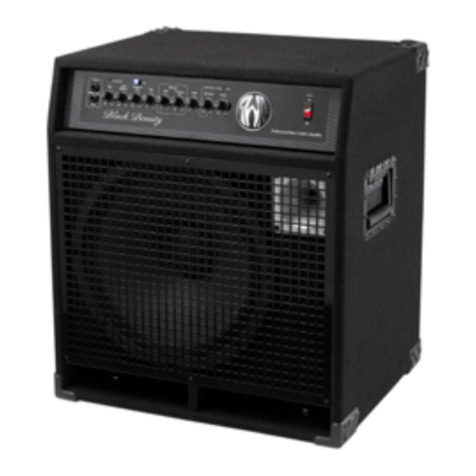
SWR
SWR Bass Combo Amplifier User manual
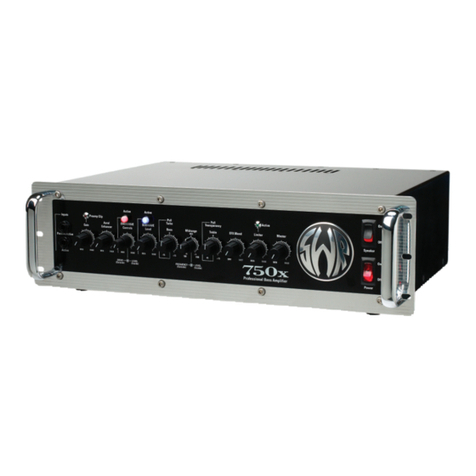
SWR
SWR 750x Bass Amplifier 750x User manual

SWR
SWR WORKINGMAN'S 10 User manual

SWR
SWR WorkingPro Series User manual
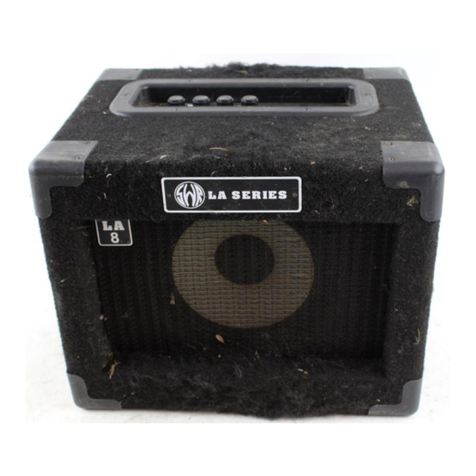
SWR
SWR LA 15 User manual
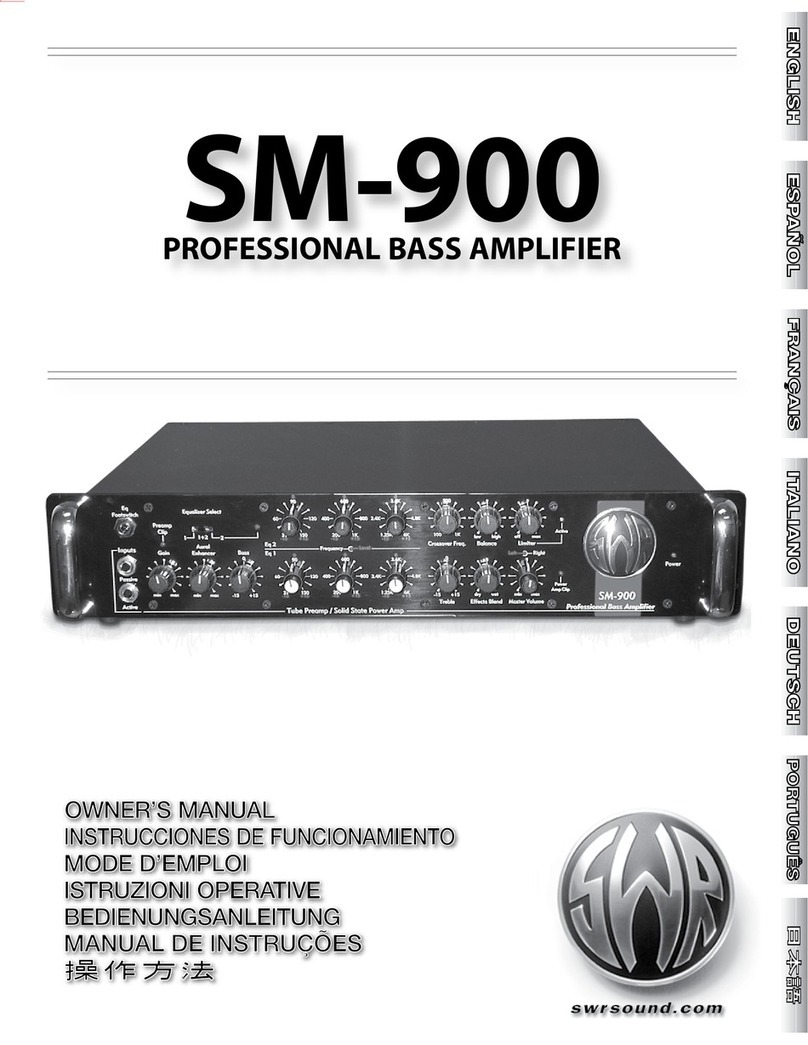
SWR
SWR SM-900 User manual
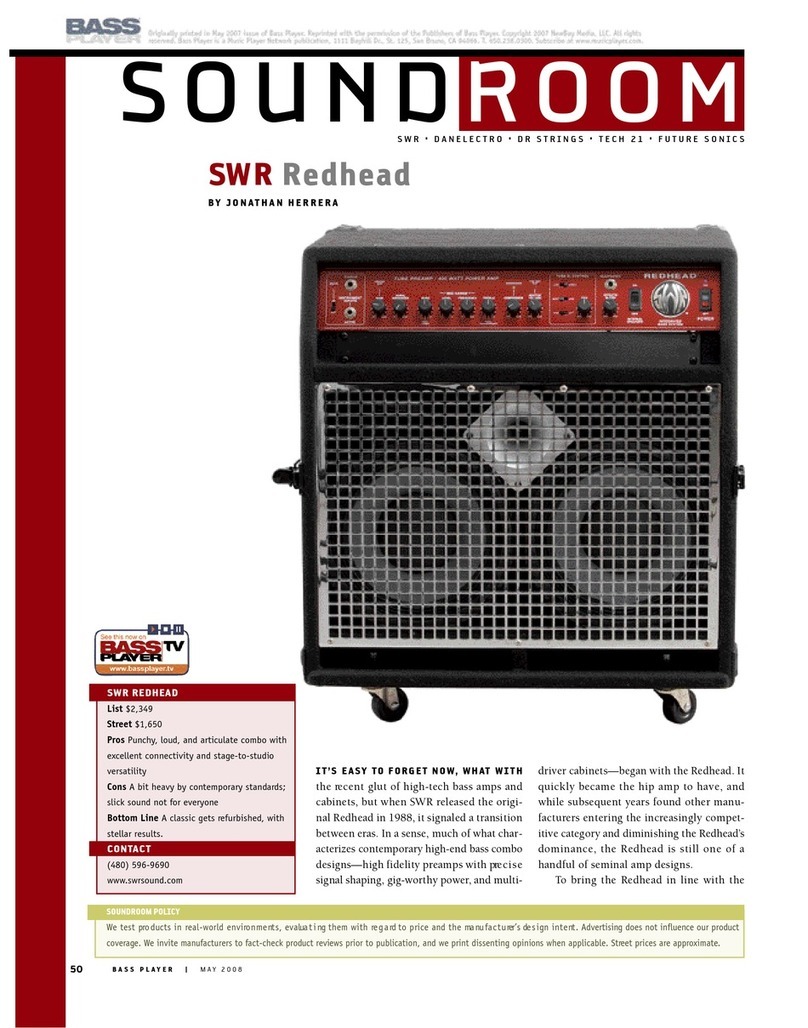
SWR
SWR Super Redhead User manual
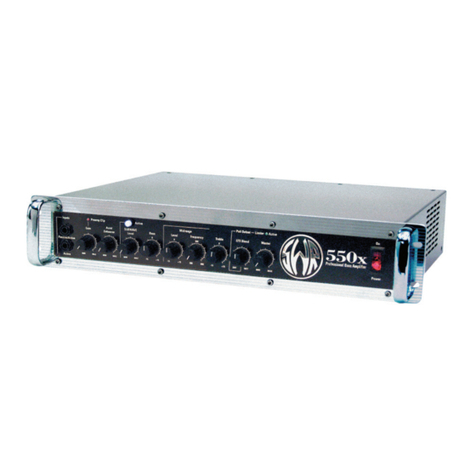
SWR
SWR 550x User manual

SWR
SWR SM-900 User manual
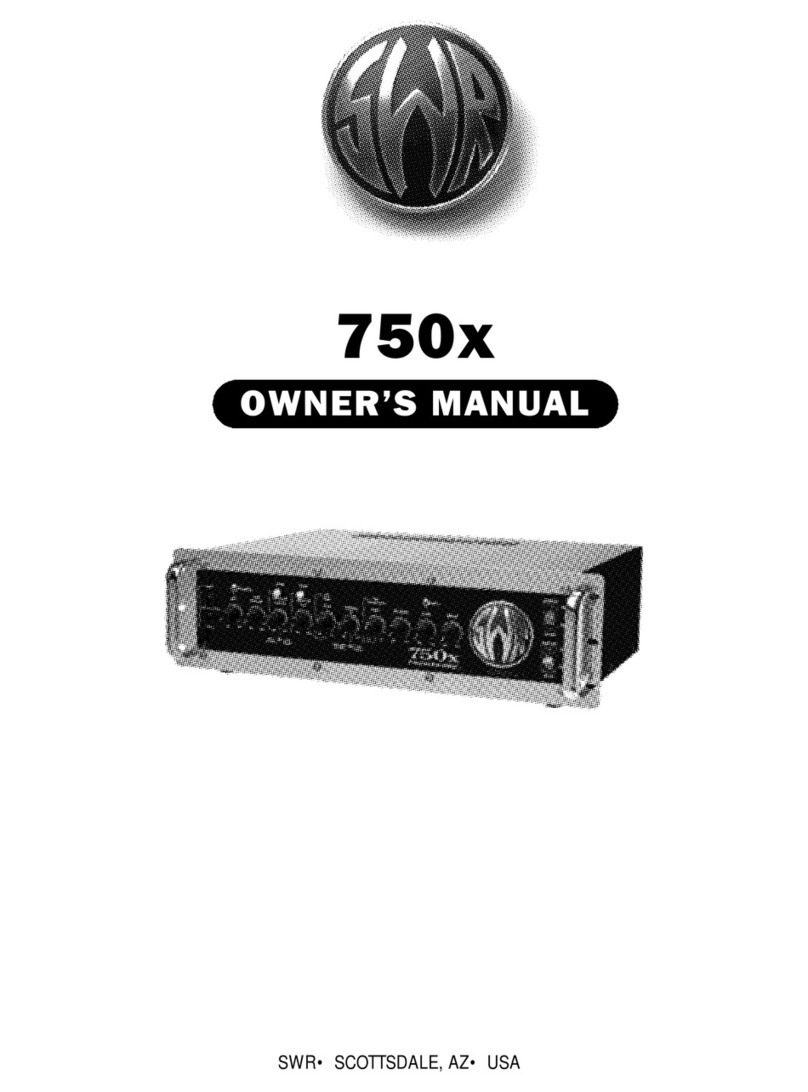
SWR
SWR 750x Bass Amplifier 750x User manual


